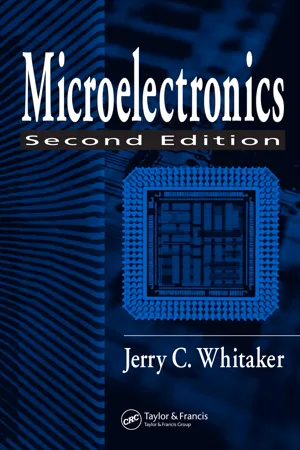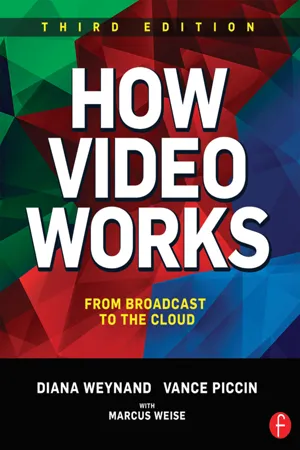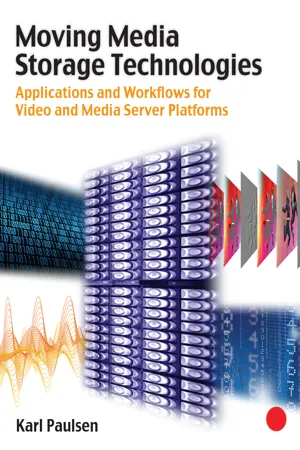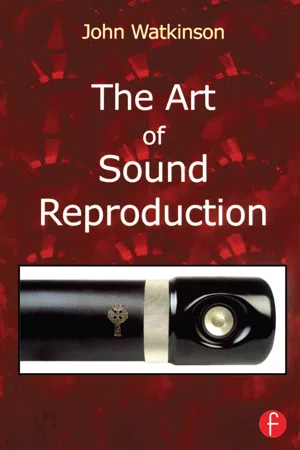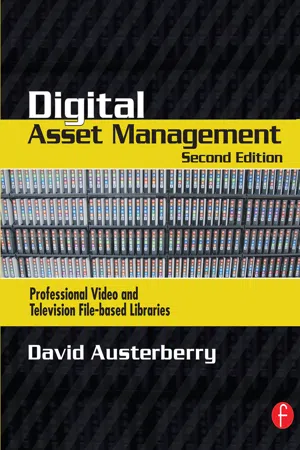Optical Storage
Optical storage refers to the storage of data on optical discs, such as CDs, DVDs, and Blu-ray discs. These discs use laser technology to read and write data, making them non-volatile and capable of storing large amounts of information. Optical storage is commonly used for archiving and distributing software, music, movies, and other digital content.
6 Key excerpts on "Optical Storage"
- eBook - ePub
- Jerry C. Whitaker(Author)
- 2018(Publication Date)
- CRC Press(Publisher)
...25 Optical Storage Systems Praveen Asthana 25.1 Introduction 25.2 The Optical Head The Servosystem • Optical Recording and Read Channel • Phase-Change Recording 25.3 Worm Technology 25.4 Magneto-Optic Technology 25.5 Compact Disk-Recordable (CD-R) Recording Modes of CD-R 25.6 Optical Disk Systems Disks • Automated Optical Storage Systems • Applications of Optical Library Systems • Future Technology and Improvements in Optical Storage 25.1 Introduction Recordable optical disk drive technology provides a well-matched solution to the increasing demands for removable storage. An optical disk drive provides, in a sense, infinite storage capabilities: Extra storage space is easily acquired by using additional media cartridges (which are relatively inexpensive). Such cost effective storage capabilities are welcome in storage-intensive modern computer applications such as desktop publishing, computer aided design/computer aided manufacturing (CAD/CAM), or multimedia authoring. 25.2 The Optical Head The purposes of the optical head are to transmit the laser beam to the optical disk, focus the laser beam to a diffraction limited spot, and to transmit readout signal information from the optical disk to the data and servo-detectors. The laser diode is a key component in Optical Storage, whether the recording technology is magneto-optic, ablative WORM, or phase change. Early generations of optical drives used infrared lasers emitting in the 780 nm or 830 nm wavelengths. Later generation of drives use red laser wavelengths emitting at around 690 nm. The lasers are typically rated to have a maximum continuous output power in the 40-mW range and are index guided to ensure good wavefront quality. In a laser diode, light is emitted from the facets, which are the cleaved ends of the waveguide region of an index guided laser. The facet dimensions are small enough (order of a few micrometers) for diffraction to take place as light is emitted from the facet...
- eBook - ePub
How Video Works
From Broadcast to the Cloud
- Diana Weynand, Vance Piccin(Authors)
- 2015(Publication Date)
- Routledge(Publisher)
...20 Recording and Storage Formats As discussed earlier in this book, all video images begin as a form of light, which is then converted to electrical signals. These electrical signals can then be stored to solid-state devices or converted to either magnetic or optical signals for purposes of recording on tape or disk. At the beginning of all productions, thought is given as to the specific recording format that will be used to capture the material in the shoot. At the end of the shoot, thought is again given as to how that material will be stored for use during post production or archived at the end of the project. In previous chapters, you’ve learned about large-scale workflows and digital distribution options. In this chapter, you will take a closer look at the different recording and storage formats available for these purposes. Optical Media While analog video was primarily recorded magnetically using videotape in a videotape machine, the digital video signal can be stored electronically, magnetically or optically. Optical media is a development of the digital domain. It is not used for analog recording or storage, only for recording or storing digital data. The primary difference between magnetic and optical media is that magnetic media are volatile, meaning that the information can be lost accidentally by exposure to a strong magnetic field. Optical media, on the other hand, are non-volatile. The data, once recorded, cannot be changed or erased except through direct action by the user. Optical Recording All optical media use laser technology for recording, storing, and reproducing digital data. There are three primary components of a laser system: a laser, a lens, and the recording media. Let’s take a look at how they work together. Figure 20.1 Coherent and Incoherent Light Frequencies Ordinary light, such as a light bulb, is referred to as incoherent light. Incoherent light is composed of multiple frequencies that are scattered in all directions...
- eBook - ePub
Moving Media Storage Technologies
Applications & Workflows for Video and Media Server Platforms
- Karl Paulsen(Author)
- 2012(Publication Date)
- Routledge(Publisher)
...We find those form factors to be in the shape of solid state memory, transportable spinning hard disk drives, data tape, videotape, holographic devices, and optical mediums. This chapter focuses primarily on the evolution of Optical Storage, which includes familiar recent developments such as Blu-ray Disc and less familiar forms, such as the early laser disc and holographic recording. KEY CHAPTER POINTS • Defining removable optical media along with the development of the compact disc (CD), DVD, laser disc, and Blu-ray Disc followed by the death of HD DVD • Holographic media for data storage, its development and history, and how holograms are made for moving images and other data using various innovative technologies • Guidelines for the care, storage, and handling of optical media Defining Removable Media Removable media that contains data may be divided into two broad categories: (1) those which are essentially self-contained storage systems (e.g., a USB stick, SSD memory card, a transportable hard disk, or a solid state drive) and (2) those which depend upon a secondary mechanical device that performs the read and/ or write functions to and from physical media (e.g., a CD-ROM, DVD, or laser disc). These kinds of media are intended to be easily interchanged and can be stored in an off-line environment usually for indefinite periods of time. Removable Hard Drives Although it is certainly possible to remove the spinning hard drive from your personal computer by opening the chassis and disconnecting it from the rest of the computer, this is not a practical approach for most of the common applications for the physical exchange of media. Drive products that can be removed from a chassis and plugged into another chassis, which are actually hard drives and which differ in physical architecture from transportable drives, are still available and employed when highvolume data sets are needed...
- eBook - ePub
- John Watkinson(Author)
- 2013(Publication Date)
- Routledge(Publisher)
...11 Optical disks in digital audio Optical disks are particularly important to digital audio, not least because of the success of the Compact Disc, followed by the MiniDisc, DVD and magnetooptical production recorders. 11.1 Types of optical disk There are numerous types of optical disk, which have different characteristics.1 There are, however, three broad groups, shown in Figure 11.1, which can be usefully compared. 1 The Compact Disc and the prerecorded MiniDisc and DVD are read-only laser disks, which are designed for mass duplication by stamping. They cannot be recorded. 2 Some laser disks can be recorded, but once a recording has been made, it cannot be changed or erased. These are usually referred to as write-once-readmany (WORM) disks. Recordable CDs (CD-R) and DVDs (DVD-R) work on this principle. 3 Erasable optical disks have essentially the same characteristic as magnetic disks, in that new and different recordings can be made in the same track indefinitely. Recordable MiniDisc and CD-RW are in this category. Sometimes a separate erase process is necessary before rewriting. The Compact Disc, generally abbreviated to CD, is a consumer digital audio recording which is intended for mass replication. Philips’ approach was to invent an optical medium having the same characteristics as the vinyl disk in that it could be mass replicated by moulding or stamping. The information on it is carried in the shape of flat-topped physical deformities in a layer of plastic. Such relief structures lack contrast and must be read with a technique called phasecontrast microscopy that allows an apparent contrast to be obtained using optical interference. Figure 11.2 (a) shows that the information layer of CD and the prerecorded MiniDisc is an optically flat mirror upon which microscopic bumps are raised. A thin coating of aluminium renders the layer reflective...
- eBook - ePub
- John Watkinson(Author)
- 2012(Publication Date)
- Routledge(Publisher)
...Chapter 11 Optical disks in digital audio Optical disks are particularly important to digital audio, not least because of the success of the Compact Disc. Ten years later the MiniDisc and magneto-optical mastering recorders took optical disk technology a stage further. 11.1 Types of optical disk There are numerous types of optical disk, which have different characteristics. 1 There are, however, three broad groups, shown in Figure 11.1, which can be usefully compared. (1) The Compact Disc and the prerecorded MiniDisc (MD) are read-only laser disks, which are designed for mass duplication by stamping. They cannot be recorded. (2) Some laser disks can be recorded, but once a recording has been made, it cannot be changed or erased. These are usually referred to as write-once-read-many (WORM) disks. Recordable CDs work on this principle. (3) Erasable optical disks have essentially the same characteristic as magnetic disks, in that new and different recordings can be made in the same track indefinitely. Recordable Minidick is in this category. Sometimes a separate erase process is necessary before rewriting. The Compact Disc, generally abbreviated to CD, is a consumer digital audio recording which is intended for mass replication. Philips’ approach was to invent an optical medium which would have the same characteristics as the vinyl disk in that it could be mass replicated by moulding or stamping with no requirement for it to be recordable by the user. The information on it is carried in the shape of flat-topped physical deformities in a layer of plastic. Such relief structures lack contrast and must be read with a technique called phase contrast microscopy which allows an apparent contrast to be obtained using optical interference. Figure 11.2(a) shows that the information layer of CD and the prerecorded MiniDisc is an optically flat mirror upon which microscopic bumps are raised. A thin coating of aluminium renders the layer reflective...
- eBook - ePub
- David Austerberry(Author)
- 2012(Publication Date)
- Routledge(Publisher)
...A favored tape library for media applications is the SL8500 modular system It scales from 1,448 slots to 300,000 slots and up to 2,048 tape drives.. It can be expanded with no system downtime. Figure 15.4 StorageTek SL8500 Tape Library. © Sun Microsystems Optical Storage There are two principal families of Optical Storage: write once and write many times. The write once is used for archiving. The write many times, or rewritable, can be used for near online storage to extend the capacity of magnetic disk arrays. There are a number of different recording technologies. Some are only suited to write-once applications. For rewritable disks, there are two popular technologies: the first is magneto-optical and the second is the phase change that is used by the CD-RW and DVD. An emerging technology uses holography. Magneto-Optical (M-O) The M-O recording format was developed by the data-storage industry to replace the microfiche as a removable storage medium that could be used for backup and archive applications. M-O is also rugged and durable compared to magnetic disk and tape alternatives. The M-O disk uses a property of ferromagnetic materials called the Curie point or temperature. Above that temperature, the material loses its polarization. The recording layer on the disk has a Curie point of around 300°C. The initial state of the drive is with all the domains aligned in the same direction. A laser is used to heat the surface layer of the disk to above the Curie point. A solenoid produces a magnetic field, which can reverse the polarization of an individual cell on the surface. As the disk rotates the cell away from the beam, it cools, thus retaining the magnetic orientation. At room temperatures, this is very stable. To erase data, the magnetic field is reversed so that all cells are aligned to the initial state (Figure 15.5). Figure 15.5 M-O disk write and erase To read the state of a cell, the laser beam alone is used...
